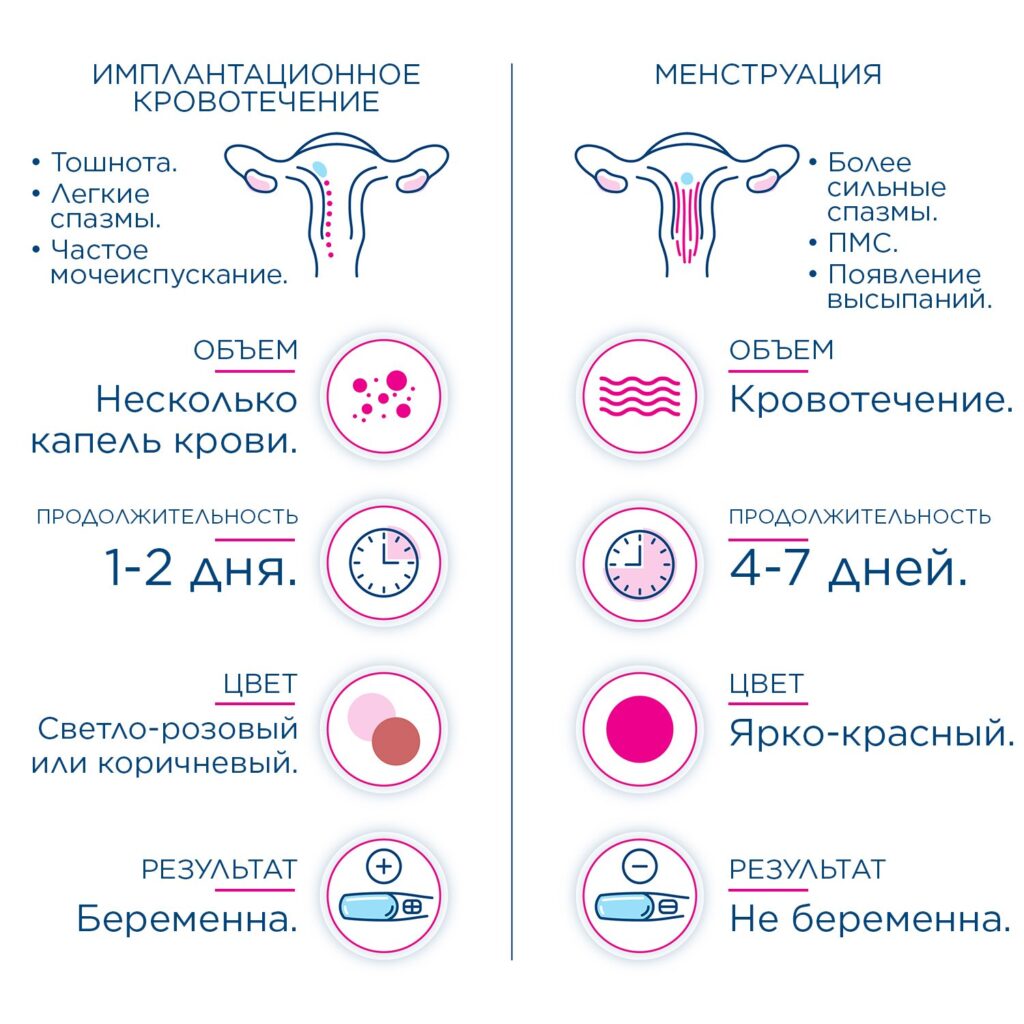Implantation is the process during which the fertilized egg attaches to the walls of the uterus. This may cause small blood clots, which are a clear indication of successful conception. The process has several differences from menstruation, so it can be identified by specific signs.
During pregnancy, implantation bleeding is a bloody discharge. It becomes noticeable in the early stages of carrying a child. Its cause is the attachment of the fertilized egg to the lining of the uterus. As the egg moves, the vessels of the uterine walls may burst, leading to the formation of these discharges. This phenomenon is completely natural and somewhat resembles menstruation.

What It Is
The implantation bleeding is the primary sign of a successful conception. This occurs because the fertilized egg attaches itself to the walls of the uterus. As the egg passes through, small blood vessels are damaged. The blood enters the cervix and then exits into the vagina.
When this happens, don’t panic. It’s better to find out more about implantation bleeding to understand what’s happening to the female body after conception:
- After fertilization, the egg begins to move towards the uterus;;
- Next, the egg implants into the endometrium;
- Upon attachment of the egg to the mucous membrane, its integrity is disrupted;
- Then small vessels are slightly damaged;
- Typically, implantation bleeding occurs 6-12 days after intercourse.

Many are interested in the specific day of the cycle when implantation begins. For each woman, this occurs differently. It should be taken into account that quite often this process goes unnoticed. This is because symptoms are either completely absent or coincide with the first day of menstruation. This often happens when pregnancy is not planned.
Main Symptoms
Many are very interested in how to recognize implantation and not confuse it with just the start of the cycle. One of the most common reasons for confusion is that implantation begins two weeks after conception, precisely at the time when menstruation usually starts. This timing is purely conditional.
Thus, implantation bleeding can occur at any time during the first trimester. Its duration ranges from 1 to 3 days. The volume of blood is much less than during menstruation, and the color is darker. The color may vary.
Fresh clots are mostly bright red in color. If they are pink or orange, it means there are other vaginal discharges. Old blood will have a brown color due to oxidation, and in this case, it will also be thicker.

It is quite difficult to independently determine deviations from the norm. Conception can be excluded or confirmed by an hCG test. However, if blood clots are associated with the start of the cycle and menstruation, they will have characteristic signs. In case other symptoms also appear, including general malaise, the best option would be to err on the side of caution and consult a doctor.
The Main Difference from Menstruation and Other Nuances
Many people confuse implantation with menstruation, especially if it starts on the 11th-14th day of the cycle or after conception. Each woman’s menstruation has its differences: some have heavier flows, some have scanty flows. However, when deviations from the norm occur, it is impossible not to notice them. Even with an irregular cycle, the type, volume, and duration of menstruation will be entirely different. It is by these signs that implantation bleeding is determined. Among them:
- Volume of discharge. Implantation involves light bloody spotting. Therefore, during heavy menstruation, it is quite easy to distinguish one from the other;
- Duration. Generally, menstruation lasts no more than seven days, while implantation lasts from a few hours to two days. During the first pregnancy, the duration may be slightly longer;
- Color. Implantation bleeding is rarely heavy, so stains can range from pink to bright brown;
- Consistency. During menstruation, dense clots may occasionally occur, but this is not characteristic of implantation. In this case, the blood always has a uniform consistency.

If other early pregnancy signs are also present, this further confirms the occurrence of discharge. To be sure, it is advisable to buy a test that reacts to hCG and perform it at home. Or schedule an appointment with a gynecologist.
In the case of implantation bleeding, you are likely to notice only a few drops of blood on your underwear. At an early stage, you can’t be absolutely certain of the harmlessness of any form of discharge, so consulting a doctor is a sensible option.
Implantation bleeding during pregnancy does not have an unpleasant odor. Its intensity is short-lived, so it may even go unnoticed. There are no specific sensations. Only in very rare cases, when conception is successful, the expectant mother may feel tearful, irritable, experience a metallic taste in the mouth, and mild morning nausea.
How to Identify
Typically, implantation bleeding presents as spotting or not very heavy discharge. Usually, it is not very intense and does not contain clots, unlike a normal menstrual cycle. If there are no other reasons to suspect pregnancy, it can be confidently stated that this type of discharge most likely indicates the beginning of a cycle.
This process occurs only in a third of cases. Therefore, there is a possibility that it may not happen. However, if the discharge is indeed related to pregnancy, other signs will also be present:
- Morning sickness. It can start as early as 4 weeks after conception or as late as 6 weeks. The sickness is temporary, so by weeks 16-20, it should no longer be noticeable.
- Heightened sensitivity to smells and tastes. This is a very prominent sign of conception, directly linked to hormonal changes;
- Frequent urination. This is also a sign of pregnancy associated with hormonal fluctuations;
- Breast tenderness. This is related to increased blood flow and fluid retention in the breasts against the backdrop of a sharp rise in sex hormones.
- Stomach cramps. These can occur on their own or accompany implantation bleeding.

If, along with blood spots, at least one of these signs is also present, it is highly likely to indicate successful conception. On the other hand, for some girls, such symptoms indicate the start of a normal menstrual cycle. Therefore, it is necessary to focus on individual conditions.
How it looks
Many women confuse implantation bleeding with menstruation. It’s quite simple to distinguish one from the other. The main difference is that, in the first case, the discharge begins before menstruation. It will be easiest to find differences for women who were planning a pregnancy. In the context of planning a future child, small blood clots are a sign of conception.
To determine the origin of the discharge with utmost accuracy, pay attention to the following factors: color, amount, texture, and duration. The clots post-implantation should resemble egg white. There may also be streaks or small drops of blood. An unpleasant smell is completely absent. Implantation bleeding during pregnancy lasts no more than a day. Most often, this process goes almost unnoticed.

If blood clots occur during menstruation, this is usually a worrying sign. It indicates various gynecological diseases, so there is reason to consult a gynecologist.
Blood after ovulation
Typically, implantation bleeding occurs between the 7th and 12th day after ovulation. Some women experience discharge just before menstruation, which is why few consider the possibility of pregnancy. It should be noted that conception occurs directly in the tubes, and then the fertilized egg moves into the uterus.
Many girls are also interested in how long implantation lasts. It is manifested as light spotting for no more than a few days. The timing is close to regular menstruation but also has certain differences. Depending on whether the process occurs after ovulation or after fertilization, the methods of diagnosis differ.
Post-Ovulation
Every woman’s menstrual cycle varies within certain limits. However, it remains stable if a woman does not have any serious gynecological diseases. Thus, if the menstrual cycle is 31 days, implantation bleeding may occur on the 23rd-27th day of the cycle. But it will only occur if conception has taken place and the fertilized egg has attached itself to the uterine lining.
After Conception
Blood clots during implantation may also appear after conception. As a rule, this happens 6-14 days after the egg has been fertilized. This is how long it takes for the egg to enter the appropriate tubes and uterine lining.

Is There a Danger
In the early stages of pregnancy, questions may arise about whether implantation bleeding is dangerous. Throughout pregnancy, discharge can occur for various reasons. It can be cervical irritation or a mild infection. Therefore, regardless of the type of discharge and on which day of the menstrual cycle it started, the best option is to consult a doctor.
One common issue is that it’s difficult to determine whether bleeding is due to implantation or menstruation. This can create certain challenges when calculating the due date. In the early stages of pregnancy, not every woman experiences implantation. As statistics show, it occurs in only 15-25% of cases. So, if this doesn’t happen, there is no need to worry.
There is no need to worry about typical implantation bleeding during pregnancy. Whether this physiological process occurs depends on the attachment of the fertilized egg. Important factors include how quickly it attaches and where.
To identify implantation bleeding and distinguish it from menstruation or other processes, you need to know its main characteristics. First and foremost, it cannot be as heavy as menstruation. Additionally, implantation is not accompanied by general malaise or headaches.

Even if the stomach hurts, there are other distinguishing features. For example, color and duration. The appearance of blood is not always a sign of implantation bleeding. Sometimes it can be confused with more dangerous pathologies, such as an ectopic pregnancy. In such cases, you should immediately consult a doctor.
It is also possible for various sexually transmitted infections to occur. Quite often, during intercourse, the epithelium is damaged—this can cause bleeding either during or immediately after sex. There is also a risk of early-term miscarriages, but in such cases, the pain will be very intense. Bleeding may not occur after ovulation. There is nothing to be alarmed about in this situation.
Does implantation occur with IVF?
Regardless of the method of conception, every pregnant woman may encounter implantation bleeding. In the case of IVF, this phenomenon occurs in about one-third of women. It usually happens on the 9th to 12th day after the embryo has been successfully transferred. This means it is already implanted in the uterus. In addition to discharge, the following signs indicate implantation bleeding during pregnancy:
- Lowered basal body temperature—if previously monitored, significant changes in readings will be noticeable;
- unpleasant sensations in the lower abdomen;
- slight dizziness accompanied by nausea.
The duration of implantation is only a few days, so soon, instead of spotting, true signs of pregnancy will become noticeable. It should be noted that IVF is performed in several stages. Because of this, the implanted embryo needs some time to adapt to the new environment. As a result, many women begin to anxiously wonder how long it will take for implantation to begin and whether it will happen at all.
The feelings during implantation and consequently during pregnancy are identical to those that occur with natural conception. There are no significant differences in implantation bleeding either. It also occurs in the form of slight discharge and lasts only a few days without any harmful effect on the body.

Is it always the case
Implantation bleeding does not occur in all cases. Due to its scant volume, many women do not notice it at all. If this process is absent, it is not a sign of pathology. It’s just a characteristic of the body. The likelihood of implantation increases several times if the pregnancy is multiple.
If discharge begins immediately after conception and you are certain of its nature, there is no need to rush to the doctor. You can continue your usual lifestyle. There is also no need to start taking hemostatic agents. The only recommendation is to take folic acid to strengthen the uterine walls.
Special attention should be paid to nutrition and lifestyle, as well as emotional state. From a medical perspective, when spotting is detected, no intervention is usually required. If there are serious concerns, it’s best to consult a doctor immediately. Blood clots after ovulation are not necessarily negative.
Most often, this is a sign that conception is occurring properly. Upon detecting signs of implantation, it’s best to remain calm. It will stop after one or two days and will not resume. If you do consult a doctor, they may conduct an ultrasound to ensure proper fetal development. Sometimes, blood outside of menstruation can actually be beneficial as it indicates that the embryo has attached to the walls of the uterus.
Sometimes it happens that after blood clots come a normal menstruation. In this case, it is recommended to consult a doctor for more detailed advice and appropriate tests.
Conclusions
Implantation bleeding is a natural process and poses no threat to the future mother or her child. It is very important for women to distinguish implantation from discharges that occur at the beginning of the menstrual cycle. For this, attention should be paid to several signs: color, duration, consistency, smell. If any questions about pregnancy arise, be sure to consult a doctor.
When preparing for pregnancy, many questions often arise. To ease the preparation, MomsLab offers a special program called “Pregnancy.” It is the optimal choice for future moms who want access to various workouts, meal plans, and aim to find like-minded women. All you need for the program is 10 minutes a day.


Download the app and get 7 days free use
 eng
eng rus
rus deu
deu spa
spa fra
fra ita
ita por
por srp
srp tur
tur ukr
ukr por
por bos
bos



